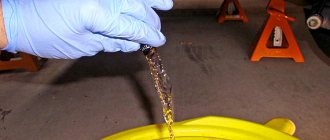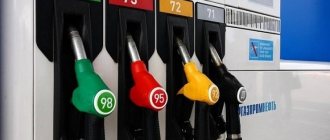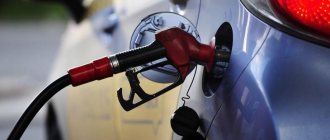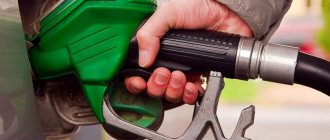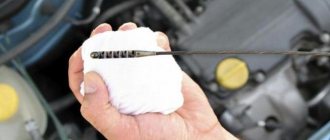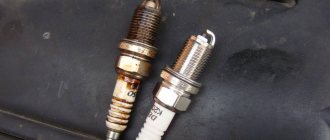There are a great many situations in which it becomes necessary to remove remaining fuel from the tank of your car.
Often this procedure is carried out when the fuel in the tank is of too low quality - no other method will help to avoid problems. Sometimes the tank is filled not with gasoline, but with the same diesel engine. Fortunately, such an oversight at a gas station is not a very common occurrence, because only if the wrong fuel does not reach the Lada engine can trouble be avoided. For this reason, action must be taken as an emergency. When the error is not noticed immediately and the car drives even for a short time on a dubious cocktail, then its owner will also need to flush the entire system and especially thoroughly the fuel pump. It is possible that the filters will also have to be changed. People driving older Lada models do not encounter any particular difficulties. In such cars, it is very easy to pump out fuel - the plug is opened, a hose is inserted inside, and then the fuel is removed using the good old principle of communicating vessels. Largus is a new car, and therefore the simple option described above cannot be implemented. We will tell you in more detail later how to drain gasoline from it differently.
Security measures
It’s not for nothing that we placed this section at the beginning of the article. After all, many people do it first and then think, but while already in the hospital.
It is important to understand that fuel should only be drained into a metal (aluminum) container. Plastic can cause a spark and fire, so using it, although convenient, is dangerous.
It is also prohibited to use an open flame when draining gasoline, to knock metal on metal so as not to cause a spark, and in some cases to carry out work on a hot engine.
Replacement frequency, what antifreeze to fill
Largus cars are filled with antifreeze designed for operation for 90 thousand kilometers, or 3 years for low mileage. But you always need to pay attention to the color; if it turns red, then it needs to be replaced earlier.
For Renault engines installed on this model, an excellent option would be the branded Renault Glaceol RX Type D concentrate. You can also use ready-made Coolstream NRC or Sintec Unlimited G12 Plus Plus fluids.
Also, many car owners recommend yellow AGA antifreeze, which is developed according to AvtoVAZ technical requirements. But you can also look at fluids that meet RENAULT 41-01-001 or Type D approval.
READ Replacing the cylinder head gasket Hover N5 petrol
bill 370
Disputes about the capacity of Largus's tank have been going on for a long time. The operating instructions say “about 50 liters”, the pistol at the gas station begins to “snap” at 47-48 liters, and someone manages to pour more than 60 liters from the pistol into the tank for a long time.
So where is the truth? Is the tank neck really more than 10 liters? Or does the gas pump start to lie shamelessly if you pour gasoline into the tank in a thin stream?
This test was planned a long time ago, and it had to happen that on the appointed day a blizzard and snowfall began! But how could I refuse the test when my teammates in Largus
-Club.RF are waiting for the test results? The test had to take place in any weather.
Two 20 liter cans of gasoline are waiting in the trunk, there is still about half of the gas tank... stop, stop, stop... something is wrong! When the half tank indicator lights up, this means that there are approximately 20-25 liters of gasoline left in the tank. We consider “at a minimum” 20 liters of residue in the tank, 40 liters of gasoline in cans - a total of 60 liters! That is NOT ENOUGH. To be honest, there is some misunderstanding in my head as to how this is so: with half a tank, 40 liters of gasoline (especially when you see them in full size) may not be enough to fill it “to capacity”!
Okay, so we’ll stop at a gas station and fill it up a little more, but so that we can also check the accuracy of the fuel level in the tank in liters, available during the test mode of the instrument panel. Let's fill in 20 liters and see how the readings change) This means that for the test it is necessary that there are 26-28 liters of fuel in the tank in order to be able to see deviations in both smaller and larger directions.
Let's get started. First, let's see the remaining fuel in the tank through the test mode of the instrument panel. 28 liters - just what you need!
The first canister goes into the tank. When there were a couple of liters left in the canister, the neck made a “gurgle” and threw a few drops of gasoline out! It is clear that at this moment, just after “having a loaf of gasoline,” the gas station pistol snaps open. We wait a few seconds and the remaining fuel in the first canister fits freely in the tank.
We look at the fuel level readings. They range between 49 and 50 liters.
We filled in 20 liters, but the level rose by 21. I doubt that at the gas station they poured a liter of gasoline into the canister more than the meter showed, which means that the instrument panel readings are not entirely accurate. But 1-1.5 liters is quite acceptable.
Let's move on to the second canister. Now, in order to monitor how much will go into the tank, and to make it more convenient to fill the fuel slowly, we will use a “measuring canister”. Which means it’s time for the fire extinguisher to appear:
The first “measuring canister” (slightly less than 5 liters) disappeared without a trace in the neck of the tank. The second one also left without a trace. I thought the third one would already leave, but no, a stack of gasoline spilled from the neck. Stop, everyone, the box is full! Just in case, I shook the car. Nothing changed. In total, another 14 liters were included.
We double-check: the remainder is not included in the tank from the 3rd canister
Fill another measuring canister completely
The fuel reserve readings are frozen at a maximum of 50 liters
In total, about 6 liters did not fit into the 40 liter tank.
So how much can fit? According to instrument readings, there were 28-29 liters in the tank (taking into account the error of instrument readings), another 34 liters were added, for a total of 62-63 liters.
This reserve is quite enough to travel from Moscow to St. Petersburg without gas stations.
Where are the 14 liters of difference between the passport and obtained values hidden? look at the schematic image of the tank:
Here is his photo, although not very beautiful, but clear
Pay special attention not only to the length and curved neck, but also to the protrusions at the top of the tank. Air and gasoline vapors leave them slowly, so even with high pressure, gasoline has “nowhere to go,” and if you pour it slowly, these cavities are filled with gasoline.
But why was it done this way, and why does the manufacturer recommend refueling “up to 2 cut-off points of the refueling nozzle”? After all, a large tank has always been considered an advantage.
It's all about SAFETY! Gasoline changes its volume quite significantly with temperature changes. Therefore, gasoline containers always provide for unfilled space. It is enough to imagine the simplest situation to understand how important this is: Let’s imagine that you refueled your car on a cool night, topped it up, and drove a kilometer home, leaving it in the parking lot. In the morning the sun came out and it was hot outside. You can’t fool physics, the gasoline began to expand, but there was nowhere for it to go - and it, squeezing out the seals and seals, leaked through the plug and poured into the street. I think there is no need to explain how dangerous a puddle of gasoline is?
In addition, looking at the drawing of the fuel tank, an attentive person will pay attention to one more feature. Number 7 shows the fuel pump cover. Look - it is located in a kind of “depression” much lower than the upper parts of the tank. That is, at the slightest violation of the tightness of the fuel pump installation (and this often occurs after any work with it, since its correct installation requires time and experience). Gasoline will flow in a stream, including onto the power contacts of the fuel pump.
READ Replacing thermostat LADA Kalina 8 valves
So, filling the tank “up to two clicks” is not just empty words associated with the shortcomings of engineers who did not correctly create the tank ventilation system. In fact, this is a safety requirement! And you shouldn’t neglect them. Yes, a good owner should know the “hidden capabilities” of his car, but he should know much better what risks are involved in violating the car’s operating instructions.
Here I talked and talked... and after the test, my tank was completely leaking. Draining gasoline from a car in the cold is extremely inconvenient, so after the test I still had an almost 100-kilometer trip ahead of me...
Domestic cars
Let's look at 5 ways to drain fuel on popular brands of the domestic automobile industry.
VAZ 2110, 2112, 2114 (injector), Lada Granta
The methods listed below are also suitable for those cars where there is a protective mesh in the fuel neck.
Method 1.
Drain fuel only when the engine is cold.
Would need:
- connector for connecting to the fuel pump (sold separately) and a wire to it up to 3 meters long.
- a hose up to 3 meters long and with a diameter suitable for the fuel pump fitting.
- clamp;
- two crocodiles for connecting to the battery;
- metal canister;
- rags.
Algorithm of actions:
- Fold down the two rear seats and unscrew the fuel pump access flap.
- Disconnect the wire connector.
- Relieve pressure in the system. To do this, remove the engine protective cover. Find the special fitting (it is shown in the photo below) and release the pressure by pressing the button. To prevent fuel from spilling, place a small container with a volume of up to 0.5 liters.
- Find the fuel supply hose on the pump; as a rule, it is single. Double return hose. Follow the arrow on the pump cover.
- By pressing the bracket, remove the fuel supply hose.
- Connect the prepared hose to the fitting and secure it with a clamp. Place its other end into the prepared container.
- Connect a pre-prepared connector to the pump by first extending its wire to 3 meters.
- Remember where the positive and negative wires are located and use alligator clips to connect them to the battery. Plus to plus, minus to minus.
- Gasoline will begin to flow into the container.
- Reverse the steps to return everything to its original position. Please note, do not rush to remove the hose from the canister. First, disconnect it from the fitting and drain the remaining fuel.
Method 2.
Similar to the first one, only we disconnect the hose in front near the engine:
- To the right of the engine near the exhaust manifold, find the fuel supply hose. It releases easily thanks to the spring latches. The disconnect location is shown in the diagram below.
- Connect to it a pre-prepared hose at least 3 meters long. Place the other end into a metal container.
- Turn on the ignition. The pump will start working and pump out fuel. It is not recommended to start the car as the pump may fail.
About 100 - 150 ml of gasoline will drain at a time. Next, turn off the ignition and turn it on again.
Method 3.
Suitable for injection vehicles VAZ 2110, 2112, 2114, Lada Granta. We also take a hose and container.
- Remove the fuel pressure valve cap and use a regular cap to unscrew the nipple.
- Insert the hose. We lower its second end into the canister.
- Turn on the ignition. While the pump is pumping, fuel will drain.
- We repeat the procedure until we add the required amount of fuel.
Methods 2 and 3 are not suitable for situations where you need to completely drain the gasoline. Frequently turning the ignition on and off will quickly drain the battery, and if you start the car, there is a high probability that the pump will idle and burn out.
On the Lada Granta we also find a fitting for measuring pressure, it is located in the same place as on the VAZ 2110. All operations are performed in the same way.
Alternatively, you can use the following method.
Method 4.
The hose is connected using the methods already described above or directly to the fuel rail.
We find the fuel pump relay and close the contacts on it. On 2112, 2111, 2110 the relay is located below to the right of the driver.
Turn on the ignition. The pump will run continuously. But here it is important to know how much fuel is in the tank in order to control the draining process and prevent the pump from burning out. The entry of air with fuel is a signal that the ignition needs to be turned off.
In this simple way you can drain gasoline from the injectors of domestic cars.
VAZ classic (carburetor), old foreign cars
Option 1.
As a rule, in such cars there is no mesh in the neck, therefore, in order to drain fuel from the tank, it is enough to have a special hose with a bulb for pumping fuel.
We lower one end of the hose into the gas tank, the other into the canister and begin pumping. Usually at 5-10 pumping, gasoline begins to flow.
Please note that on the bulb itself there is an arrow indicating the direction of fuel movement.
Option 2.
Using a regular hose and your lungs. It is important here not to inhale gasoline vapors or swallow flammable liquid.
To prevent this, use a transparent pipe that is not too thick (4-6 mm) and not very long (from 2 to 3 meters no more). We cut one side at an angle of 70 degrees, this will allow fuel to drain better.
Lower the hose into the tank so that it touches the bottom. Then, if you haven't cut it, lift it a couple of centimeters. This is done so as not to block the hose hole with the bottom of the tank.
The ideal option is for the hose to lie on the bottom of the tank in a semi-circle, this will ensure maximum pumping of fuel. To do this, attach a small weight near the end of the pipe. Where the fuel line has several bends, the option with a load does not work.
Start sucking, with your mouth below the expected level of gasoline in the tank.
The higher the fuel rises through the tube, the harder it will be to create a vacuum. If the hose is transparent, then the process will be visually visible.
As a result, gasoline will begin to drain, the main thing is to redirect it from the mouth into the canister in time.
What mistake was made in the video, write in the comments.
Option 3, 4.
For those who are afraid of swallowing fuel, you can assemble the following structures.
Take a 1.5/2.0 liter container and make two holes in its lid. Insert two pipes and fill the place where they go with epoxy resin. Screw on the cap.
The end of the hose through which air will be sucked in should be higher in the bottle than the one that goes into the tank. This can be seen in the diagram.
We begin to suck in air, without inhaling gasoline vapors and eliminating the possibility of tasting the flammable liquid.
Or, in order to drain fuel from the tank, we use a homemade pump. To do this, take the same pipe as in the method described above (maybe a little thicker) and a rope 10% longer.
Pass the rope through the hose and tie a knot at one end so that it passes through the hole with force.
Soak the knot in water and tighten it into the hose. The swollen node will completely block the passage. Place the knotted end of the hose into the tank and begin pulling the rope through. The vacuum created will pull fuel with it, which will eventually begin to drain.
Option 4.
Using a vacuum cleaner. For this you will need:
- the vacuum cleaner itself;
- container with a tight lid;
- two rubber tubes.
We assemble the structure:
- We make two holes in the lid of the container into which we tightly insert two hoses. Fill the area with epoxy resin to prevent air from passing through.
- We connect the first pipe through a seal (or in another way) to the vacuum cleaner, and lower the second pipe into the tank.
Turn on the vacuum cleaner for suction. Thanks to the vacuum created, gasoline will begin to flow into the container.
Option 5.
Tritely simple. Find out whether the design provides for the presence of a drain plug in the gas tank of your car.
If yes, then drive the car onto a pit (overpass) or lift it with a lift. Unscrew the plug and drain the fuel.
By the way, if there is no such plug, you can install it yourself.
The disadvantage of this method is obvious; it eliminates the possibility of quickly draining fuel on the road, for example, if you need to help someone.
UAZ Patriot
On a UAZ Patriot, draining gasoline from the tank using the usual “folk” method will not work. You can use a fuel pressure valve for this. We find it and unscrew the spool with the cap. We collect the spilled fuel into a prepared container.
We connect a pipe with a diameter of 8 mm to the valve.
We find the fuse box, remove the cover and find the fuel pump relay in it. Remove and install the jumper to complete the circuit. It is advisable to insert a 5-10A fuse into the jumper itself.
Even without the key inserted into the ignition, gasoline will begin to drain. In 3 minutes you can drain up to 10 fuel.
Niva Chevrolet
The Niva Chevrolet has a fuel tank installed in the body and therefore does not have a drain hole. But the advantage is that there is no protective mesh in the filler neck pipeline and it is relatively flat. Therefore, most of the methods described above are suitable for draining gasoline in this case.
It is important to consider that the tank itself is located far from the filler neck, so in order to capture the fuel, the pipe must be about 3 meters long and with a diameter of 4 to 8 mm.
Also, many car owners, to protect against fuel drainage, install a meat grinder mesh with large holes in the filler pipe of the Niva Chevrolet.
If you have installed such a grid, then you will have to drain the fuel using a gas pump (this is discussed above).
Lada Priora, Kalina
The fuel tank of the Lada Kalina is made of plastic; gasoline is not drained from below. Also, the filler hole itself is located in the center of the tank, and not on the side.
Therefore, the pipe from the filler neck to this hole is long and has two bends.
The advantage is that there is no protective mesh in the filler pipe. Therefore, all is not lost.
Prepare a canister and a hose at least 2.5 - 3 meters long with a diameter of 1-1.5 cm. So that it fits freely into the neck.
Run the hose inside. At first it will go freely and even the first bend will not cause any special difficulties. Then it will rest against the second bend and here you need to start rotating it counterclockwise, as if you were cleaning a sewer.
Blow into the hose and make sure it goes down into the tank. Drain the gasoline using a blower or by creating a vacuum with your mouth (methods described above).
The problem is that the fuel tank on the Lada Kalina is too low, and therefore you will have to bend down to the ground for the fuel to start draining. Or drive the car into a pit or overpass.
You can also drain the fuel from the Lada Kalina (Cross) by connecting to the fuel system through the fuel pressure control valve, we wrote about this above. Or get to the fuel pump through the rear seats, see how to do this above.
Using the same methods, you can drain fuel on the Lada Priora.
A few nuances
On forums, some car owners say that they drain gasoline using a regular household pump of the “Springhead” type. This is not recommended, because any electrical appliance can spark, which means there is a risk of fuel ignition.
Other hobbyists say that to simply remove gasoline, you just need to use up its entire volume, as evidenced by turning off the power plant. This method is extremely dangerous. The thing is that in this case there is a high risk of damage to the pump. This unit, which, as they say, works dry, can burn out, and you will have to pay more than a thousand rubles for a new one.
We use pumps
Technologies do not stand still. To drain fuel from the tank, you can use ready-made solutions - these are manual and electric pumps for pumping liquids.
Electrical devices will require 12V/24V power. They are either submersible or non-submersible. For passenger cars, the second option is suitable.
But you need to understand that there are pumps that can only pump diesel fuel, water, oils, but not gasoline. Therefore, before purchasing such a device, carefully read the instructions for it.
But for non-everyday use, it is more advisable to have hand pumps; they are much cheaper and no less effective.
Why might you need to drain the gasoline?
It often happens that very low quality fuel gets into the tank, which is dangerous for the car and can even damage some of its components. You can notice such a problem by the fact that immediately after refueling the car begins to move at a jerky pace, or by the fact that the engine stalls and refuses to start again. In this situation, it is necessary to drain the low-quality gasoline and replace it with a new one of higher quality.
But, if in cars of previous years of production this was quite simple to do, using a regular hose, then for the Lada Grant the solution to the situation has become much more difficult.
Lada Largus, Renault Logan, Sandero, Duster
It is no coincidence that we classified Lada Largus as a foreign car, because this car is made on the Renault platform, which means their fuel systems are similar, especially with Renault Logan.
The fuel tanks of these cars are located low, so you won’t be able to drain the fuel using a hose, but you can go the other way.
Remove the back seat so you can get to the fuel pump. Connect the pumping hose to the outlet fitting. Next, close the pump relay. The latter will begin to pump out gasoline.
For example, let's take Renault Duster. First, relieve the pressure in the system. To do this, disconnect the electrical connector from the pump and start the car for a few seconds.
Further:
- Prepare a PVC hose with an internal diameter of 10 mm. Since the fuel supply flange has a diameter of 11 mm, this will eliminate air leaks.
- Using a screwdriver, connect one end of the pipe to the fitting, and lower the other into the canister.
- Find the pump relay, marked “K 4” in the diagram and close contacts B5 and B3 on it.
- The pump will begin to drain gasoline, but the ignition key will not turn.
IMPORTANT: Do not allow air to enter the pump.
Method 2. Drain gasoline through the fuel line and the plug at the bottom of the gas tank
If the fuel pump is located not in the tank itself, but near the engine, you can try to drain the fuel through the fuel line. Procedure:
- Unscrew the clamp and disconnect the hose going from the tank to the fuel pump.
- Place the hose into the fuel container.
Fuel will leak from the gas tank. The main thing is that the end of the fuel line, as well as the fuel container, is located below the gasoline level.
Some cars have gas tanks with drain plugs. If you are the owner of just such a car model, you need to use an overpass or inspection hole to drain the fuel. This is done simply:
- Place a container under the drain plug in the gas tank.
- Unscrew the plug.
- Drain the fuel (all or part of it).
- Tighten the plug.
From a Ford tank
Let's look at the example of Ford Focus 2. It will not be possible to drain gasoline through the filler neck; the valve, mesh, and bends in the fuel line will not allow this to be done.
You can remove the fuel tank, but this is labor-intensive work, so the game is not worth the candle.
The option directly through the fuel pump is attractive, but provided that you have already changed this element of the fuel system before and cut a hole in the bottom under the rear seats, an explanation is here. If not, then cutting metal just to drain the fuel is impractical.
The simplest option is to disconnect the tube from the fuel rail, it is secured with a latch, connect a hose with a diameter of 8 mm and drain the fuel by turning on the ignition.
But if the tank is full, which is 55 liters, and 4 liters are drained per minute, then the whole process will take a lot of time and the battery can be drained. Therefore, we find the fuel pump relay and close two contacts on them (two lower slots). Don't forget to add a larger container.
Turn on the ignition and drain the gasoline. Be careful, it can leak even without the ignition on, immediately when the relay contacts close.
How to drain gasoline with a hose
This method is one of the most common. Probably every motorist knows him. You need to take a hose and some kind of container into which the fuel will be poured.
Next, lower one end of the hose into the tank of the donor car, and place the other into the container to be filled. Gently blow out the air by inhaling it through your mouth. Then quickly lower the tube and watch the gasoline flow, waiting for the right amount.
Despite the simplicity of the process, not everyone can use this method. This is due to the structure of the gas tanks of some cars. In addition, a person is forced to inhale fuel vapors, which will somehow affect his health.
Therefore, in some cases, an alternative option will be preferable. It involves unscrewing the cap of the car's gasoline tank. As a rule, it is located below.
Recommended Posts
Reasons for draining gasoline from the gas tank
Let's consider the main reasons for draining fuel from the fuel tank:
A fellow car has run out of gas and needs to pour a little to get to the gas station. Poor quality fuel is poured in and the car drives jerkily or the engine does not start.
This kind of “donkey urine” can be filled at a gas station instead of gasoline
The wrong type of fuel was filled at the gas station and it is impossible to continue driving, due to the high probability of failure of the main power unit.
Also, there may be other reasons why you need to drain the gasoline.
Solving a problem using a handset
A well-known and proven method is removal using a tube.
This is an old “grandfather’s” method that is still relevant among car enthusiasts today. In this case, draining occurs through a tube into a volumetric container. Today, special bulb pumps are widely used to drain gasoline. With their help, you can quickly and safely drain the required amount of fuel. In appearance it resembles a device for measuring blood pressure. If you buy it in time, you can easily drain gasoline from any car, be it a Lada Priora or a Skoda Octavia.
If the regulator is in the gas tank
Then you will have to do things a little differently.
You can try using a standard fuel pump to pump out fuel. To do this, you simply need to disconnect the hose from the injector or fuel filter. It is advisable to carry out this entire operation on a lift or inspection pit, then you can painlessly turn off the fuel filter and lower the hose into a container. When the ignition is turned on, the standard fuel pump will pump a certain amount of fuel, but only as much as it can do in 2-3 seconds. Then you will need to turn the ignition on again, and turn it off again, and so on until the required amount of fuel is in the canister. There is one nuance here - not all foreign cars will allow you to do this to yourself on the road. There may be complex systems for attaching hoses, difficult-to-reach places for their location, and other difficulties may arise when the fuel line is disconnected. After all, we simply may not have the right diameter hose if we're on the road. Then we use the third method. Radical.

